Airfix 1/72 Beaufighter TF X
Originally conceived as a heavy fighter development from the Bristol Beaufort torpedo bomber, the Bristol Type 156 was submitted to an RAF as an “interim” alternative to the Westland Whirlwind, which was experiencing development delays in 1937. Developed in accordance with specification F.11/37. Although Bristol had stated the design would utilize some 60% of the Beaufort airframe, the fuselage ended up being complete redesigned, with the first prototype, which was based on a Beaufort airframe taken off the production line, first flying July 17, 1939, eight months after design development began; 300 had been ordered “off the drawing board” before this event. The wings, landing gear, and rear fuselage were identical between the two types.
The Beaufort's Bristol Taurus engines were not powerful enough for the fighter, and were replaced with the Bristol Hercules sleeve-valve radial. Four Hispano 20mm cannon were mounted in the lower fuselage, with six .303 machine guns in the wings - four in the right and two in the left.
The first Beaufighter IF was delivered to the Fighter Interception Unit on August 12, 1940, with the first operational aircraft going to 29 and 604 Squadrons on September 2. The aircraft was quickly adapted as a night fighter, since it outperformed the Blenheim IF and IVF by a considerable margin. The Beaufighter was te primary English night fighter until the appearance of the Mosquito NF. II in 1942 and did not leave service in this role until late 1943. Seventy pilots had become night fighter aces with the Beaufighter.
With the wing guns removed and replaced by additional fuel tanks, the Beaufighter IC began entering service with Coastal Command in 1941 as a long range maritime strike aircraft, replacing Blenheims; it was also the first to carry bombs, being modified to carry two 500-lb bombs under the fuselage. Initially operating from Malta, the Beaufighter was so successful in the maritime strike role that Coastal Command ultimately became the largest user of the type. The Beaufighter VIF was adapted as the VIC, and had the capability of carrying an aerial torpedo. In 1943, development began on the Beaufighter X, which was specifically for Coastal Command. The Hercules Mk XVII, developing 1,735 hp at 500 feet was adapted to the VIC airframe to create the TF.X specifically for Coastal Command. The aircraft was adapted to carry eight 60-lb rocket projectiles launched from rails under the outer wings, or to carry a torpedo. The TF.X became the most-produced Beaufighter sub-type.
Beginning in the summer of 1943. The North Coates Strike Wing of coastal command, based at RAF North Coates on the Lincolnshire coast, developed tactics utilizing large formations of up to 50 Beaufighters firing cannons and rockets to suppress flak while the “Torbeaus” attacked at low level with torpedoes. Over 10 months before D-Day, 29,762 tons of Axis shipping were sunk. In September 1944, after a summer spent supporting the invasion , the North Coates Strike Wing moved to Banff in northern Scotland, where they became known as the Banff Strike Wing, and became the largest anti shipping force of the Second World War. Altogether, between July 1943 and May 1943, the Beaufighter strike wing accounted for over 150,000 tons of shipping, with 117 vessels sunk and many others so badly damaged as to be useless for further operation, for a loss of 120 Beaufighters and 241 aircrew killed or missing. This score was half the total tonnage sunk by all strike wings between 1942 and 1945.
Wing Commander Ken Gatward
Alfred Kitchener “Ken” Gatward was one of the outstanding personalities associated with the Beaufighter during the Second World War. Born in 1914, the son of a Police Chief Inspector, Ken Gatward joined the RAF Volunteer Reserve in 1937 as a Sergeant Pilot. Commissioned a Pilot Officer in 1940, he spent 1940-41 flying low-level missions in Blenheim IV bombers with 53 Squadron. After completing his first tour, he volunteered for a second and was assigned to 236 Squadron in Coastal Command, newly-equipped with the Bristol Beaufighter Mk.IC.
Ken Gatward flew into the history books on June 12, 1942, when he and his navigator, Flight Sergeant Gilbert “George” Kern, took part in Operation Squabble. The French Resistance had informed the Special Operations Executive that the German SS troops assigned to the Gestapo in Paris made a daily parade down the Champs Elysees between 12:15-12:45 p.m. SOE asked the RAF to help them give the SS some public grief with a strafing mission down the boulevard, dropping a French Tricolor atop the Arc de Triomphe and attacking the Gestapo HQ. Gatward was named for the mission given his experience with low-level missions over France. The first attempt was made on May 13, 1942, but bad weather over France forced an abort. On June 12, Gatward and Kern took off from Thorney Island in driving rain and 10/10 cloud cover. Once over France, the weather cleared to cloudless skies over Paris. Circling the Eiffel Tower, Gatward suffered a bird strike in his right engine but was able to fly on, dropping to an altitude of 30 feet as he roared down the Champs Elysees, heading toward the Arc de Triomphe. The German parade was late, but Kern successfully dropped the Tricolor directly on the monument. Turning to attack the Gestapo HQ, they did break up the parade that was forming late, and dropped a second Tricolor on the front entrance of the building. Arriving back at Thorney Island at 1:53 p.m., Gatward was awarded an immediate DFC and Kern the DFM. The mission of June 12 is still celebrated in France.
A year later, Gatward returned to combat, joining 404 “Buffalo” Squadron, RCAF, as a flight leader. The squadron was engaged in shipping strikes over Norway, and Gatward gained a reputation as a daring leader of low-level missions into the fjords. In March 1944, the squadron leader was lost on operations and Gatward was promoted to Wing Commander and given command.
In May 1944, 404 moved from northern Scotland to what they hoped would be better quarters on the “Cornish Riviera” in preparation for Operation Overlord. RAF Davidstow Moor turned out to be so grim that it was soon called “Stalag 404" by the men. They began operations along the Biscay coast.
On D-Day, three German Narvik class destroyers - Z32, Z24 and ZH-1 - were spotted headed toward the invasion beaches. 14 Beaufighters from 404 Squadron, armed with armor-piercing rockets, in company with 16 Beaufighters of 144 Squadron for flak suppression, and 8 Mosquitos from 248 Squadron as fighter escort, took off to intercept the German ships, where were finally sighted near Belle Isle off St. Nazaire. The Beaufighters attacked successfully with heavy damage inflicted. A second strike against these ships on June 7 with such heavy damage inflicted that the ships were forced to put into Brest. Z32 was beached.
Throughout the rest of the month the squadron and the rest of the Beaufighter strike wing went after German shipping on the Biscay coast. For his leadership in these missions, Gatward was awarded the DSO on June 11. At the end of June, they found a German convoy south of Brest and sank the cargo carriers and their escorts.
On July 5 the squadron moved to RAF Strubby on the east coast, where their assignment was to attack shipping off the Belgian and Dutch coasts. Over the course of July, they made four successful attacks against heavily-defended convoys. On August 7, Gatward landed his Beaufighter at Cherbourg, becoming the first Coastal Command aircraft to land in liberated France.
The squadron moved back to Davidstow Moor in early August and over the next three weeks made several dangerous attacks against enemy shipping. On August 14, Gatward led seven 404 Beaufighters, accompanied by seven more from 236 Squadron on an armed recce mission to the Gironde River. A group of German ships were found at the mouth of the river and attacked successfully. During the attack, Gatward's Beaufighter suffered flak damage to the left wing and engine but brought the plane home despite heavy damage to the aileron. He was awarded a second DFC for this mission.
On September 5, the Beaufighter strike wing moved to Banff, where Gatward was promoted to Group Captain and placed in command of the wing. He led them in successful strikes in Norway until the end of the year when he was taken off operations.
This Beaufighter TF.X is a replacement for the ancient Beaufighter kit Airfix first released in 1960. It is a complete redesign, to the most modern standard. The late production TF.X has already been announced for release in 2016, and given the parts breakdown and kit design, it is likely the earlier Beaufighter I and VI and the Australian Mk.21, are planned for future releases.
The kit has beautifully-restrained surface detail, with very convincing fabric-covered rudder and elevator. It also provides both the early and late horizontal stabilizers with their different elevators. It has the most detailed interior of any 1/72 Beaufighter kit. Both the early and late navigator's cupolas are provided, as well as the cupola over the radio direction finding antenna used by some Beaufighters.
Decals are provided for a “Torbeau” of 144 Squadron of the Banff Strike Wing in the fall of 1944, and a RP-armed Beaufighter of 27 Squadron SEAC camouflage and markings in 1945.
Once again, I strongly urge you to follow the instructions, which are very clear and pretty much guarantee a successful result. The model can be built in an in-flight or on-the-ground configuration, but no stand it provided for the in-flight option.
I began by painting everything while still on the sprues: fuselage interior, cockpit, engines, etc. While that was drying, I assembled the wings and the horizontal stabilizer. After doing some detailing to the cockpit I installed it and assembled the fuselage, attaching the horizontal stabilizer and vertical fin and rudder. The wings went on without problem and the whole process took perhaps two hours of liesurely effort. If you are careful in assembly, you won't use any filler anywhere. I did find it a good idea to slightly sand down the engine to reduce its circumference a bit, and to then wrap the multi-part cowling with a rubber band to get a good fit. Everything is very tight there, but the slight sand-down solves all. I attached the cockpit canopy but left the navigator's cupola off till after painting.
Painting started with the D-Day stripes. In 1/72, 24" translates to 1/3 of an inch, a measurement no ruler shows. It's also 15.5 mm, which I could do. After painting white and then masking I applied black and then covered over the stripes.
I used Tamiya German Grey for the Extra-Dark Sea Grey upper color, which needs to be weathered with sun and sea fading which is all done as post-fading. The lower surface was done with a mixture of Tamiya Sky and Japanese Army Green, which gets the Tamiya Sky color closer to being accurate. I then applied a coat of Gloss and was ready for decals.
The kit decals are very nice and create attractive models, but I had the XtraDecals sheet for the Beaufighter, and decided to do Ken Gatward's airplane, which is quite colorful. With the various options on that sheet, and the ease of doing this kit, I am pretty sure there will be others on the shelf beside this one in the future. The decals went on without problem.
I filled the airbrush cup with a mixture of Tamiya Deck Tan with 90% thinner and went and went over the model, “fading” it in various degrees over the whole airframe, decals included. When that was to my liking, I gave the model a coat of flat finish.
The rocket rails are individually attached to the baseplate, and the rockets are then individually attached to the rails. I then attached the entire assembly to the lower wings. I painted the exhaust collector ring and the “hedgehog” exhaust with Tamiya Bronze. The landing gear and gear doors were attached, the rear machine gun attached and the navigator's cupola. The canopy was unmasked and the props attached.
Another Airfix winner. Superb kit design, excellent detail, easy assembly. I think this is another one that can be listed as Best In Scale. If you choose a paint scheme with less need of masking, it really is a weekend project. Highly recommended.
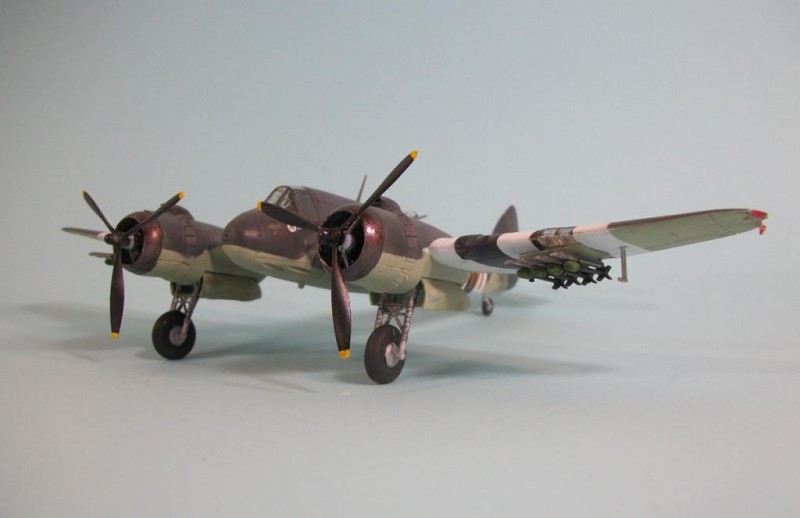
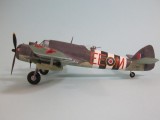
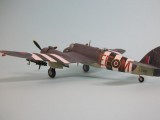
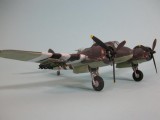
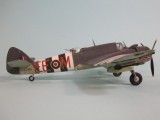
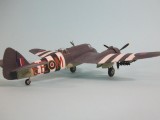

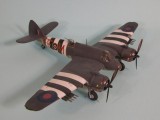

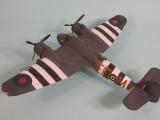

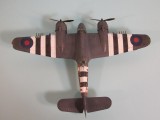

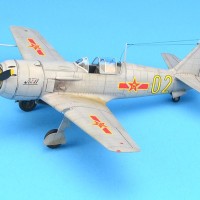
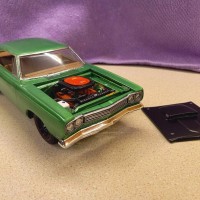
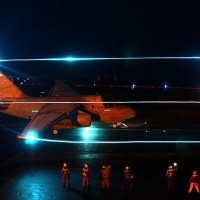
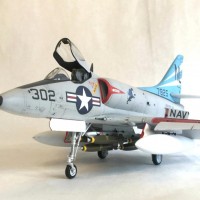
Sweet interesting history of this bird thanks.
Turned out very well
Another terrific build Tom. What I personally like reading, is the history attached to the model. It's why IMHO, most of us model in the first place. Thanks for posting!
This article is Brilliant ... TC your giving away the store in the writing dept. Some one should be paying you or its a Tax right off. Great article and build... leaving the rest of us holding rattle cans,string and glue look like amateurs. Appreciate the Osprey mini articles. These new Airfix kits are guilt free kits you can screw them up and not cry. You can afford to buy another one. Oh, I might add that the photos are sharp and crisp.
Great looking Beau, and as always, interesting history. Thanks!
Another great build and article Tom. I always enjoy reading your articles here and elsewhere. I seem to remember a similar story of Mosquitos taking on a mission to break up a scheduled parade in occupied France. But, maybe I'm confusing two or more stories.
Nice BEAU !
Like nice paint .
Great job! nice info on the bird and the build.
Nice build. - Wakes some memories. The Airfix Beaufighter was the first 1/72 kit I bought on my own some 45 years ago.
Tom, a couple of things - I see you have the port nav lights as both red whereas I thought the forward only was red and the rearward clear, although I accept there may be variations. That aside, the rear cover seems to be displaced- is that correct?!